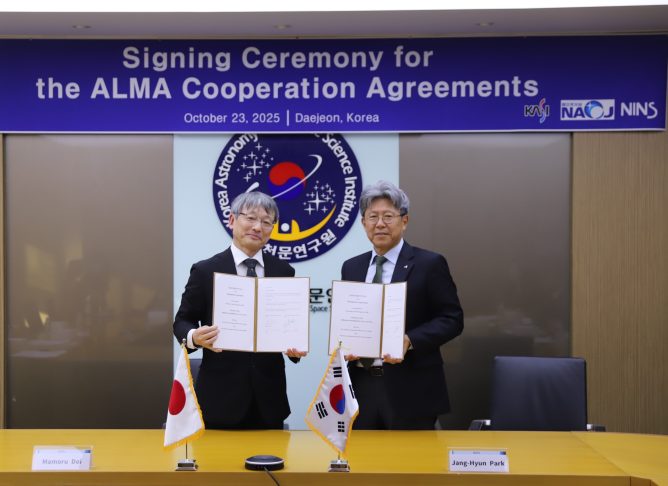
ALMA received a visit from UN Secretary-General António Guterres, who explored the array site high in Chile’s Atacama Desert. The antenna maintenance group, a crew that is key to the Observatory’s operation, is seen in this picture alongside Guterres. Credit: ALMA (ESO/NAOJ/NRAO), R.Bennett.
The Atacama Large Millimeter/submillimeter Array (ALMA), one of the largest and most sensitive telescopes of its kind in the world, received a visit from United Nations (UN) Secretary-General António Guterres, who had the opportunity to learn about how ALMA’s high-tech systems capture and combine signals from the cosmos. ALMA represents a partnership between Europe (European Southern Observatory), North America (National Radio Astronomy Observatory) and East Asia (National Astronomical Observatory of Japan), along with the Republic of Chile. These nations worked together to create a scientific instrument that none of them could build on their own.
Chile has been called an astronomy paradise, and that’s why ALMA was constructed on the Chajnantor Plateau in the country’s Atacama Desert, one of the highest and driest places on Earth. This position provides a clear view of the southern sky, while atmospheric conditions at the Plateau are ideal for ALMA’s millimeter and submillimeter observations.

At the Observatory’s laboratories, Octavio Hernández, ALMA’s Operation and Maintenance Planner-Coordinator, explains how the antennas’ receivers operate to the UN Secretary-General. Credit: ALMA (ESO/NAOJ/NRAO), R.Bennett.

Secretary-General Guterres (fourth from left) was accompanied by representatives of the ALMA partners and staff. From left to right: Iván López (ALMA’s Safety department), Luis Chavarría (European Southern Observatory – ESO), Sean Dougherty (ALMA Director), Paulina Bocaz (National Radio Astronomy Observatory – NRAO) and Tetsuhiro Minamidani (National Astronomical Observatory of Japan – NAOJ). Credit: ALMA (ESO/NAOJ/NRAO), R.Bennett.
About ALMA
The Atacama Large Millimeter/submillimeter Array (ALMA), an international astronomy facility, is a partnership of the European Organisation for Astronomical Research in the Southern Hemisphere (ESO), the U.S. National Science Foundation (NSF) and the National Institutes of Natural Sciences (NINS) of Japan in cooperation with the Republic of Chile. ALMA is funded by ESO on behalf of its Member States, by NSF in cooperation with the National Research Council of Canada (NRC) and the Ministry of Science and Technology (MOST) in Taiwan and by NINS in cooperation with the Academia Sinica (AS) in Taiwan and the Korea Astronomy and Space Science Institute (KASI). ALMA construction and operations are led by ESO on behalf of its Member States; by the National Radio Astronomy Observatory (NRAO), managed by Associated Universities, Inc. (AUI), on behalf of North America; and by the National Astronomical Observatory of Japan (NAOJ) on behalf of East Asia. The Joint ALMA Observatory (JAO) provides the unified leadership and management of the construction, commissioning and operation of ALMA.









